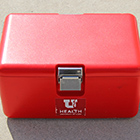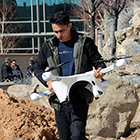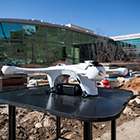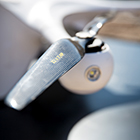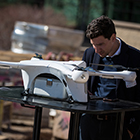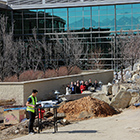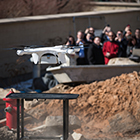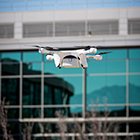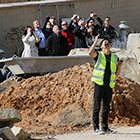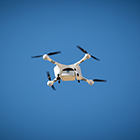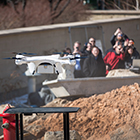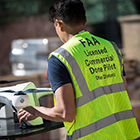You’re accessing archived content
This is archived content from the UIT website. Information may be outdated, and links may no longer function. Please contact stratcomm@it.utah.edu if you have any questions about archived content.
Health care drone delivery program gets off the ground
A health care-focused drone delivery program at the university took a major step forward — or rather, upward — during a successful test flight on February 21, 2020 near the patient patio of Huntsman Cancer Institute.
Announced in October 2019, the initiative is to develop a program in which drones ferry medical resources autonomously on a predetermined short-range flight path between the University of Utah Health's medical campus and facilities in Research Park.
"The square footage of our health facilities are increasing at a rate far greater than our roadways," said Project Owner Brent Elieson, associate director of the IT Business and Innovation Office in Information Technology Services (ITS). "As we scale, we need to look at improving time-critical care in the air, not on shared roads."
Drones are poised to fundamentally change how goods are delivered around the world — from online retail products to medical supplies. At the university, the unmanned aerial vehicles (UAVs) will transport potentially life-saving laboratory material like blood samples and perishable medicines in a secure container, as long as the cargo weighs 5 pounds or less.
"There are no cameras onboard and no surveillance capabilities — they're all electronically flown. It's all about the cargo, which is protected by a puncture-resistant, drop-proof container that's environmentally controlled," said Dave Packham, manager of UIT's UMail and Collaboration team, who was brought in as a subject matter expert on UAV piloting, rules, and regulations.
Once in operation, the service will be the first of its kind in Utah and only the second in the United States. A similar program launched in March 2019 at WakeMed Health and Hospitals in Raleigh, North Carolina. The U's drone program would leverage an established Federal Aviation Administration-sanctioned partnership between the United Parcel Service's Flight Forward drone delivery program, in charge of logistics, and Matternet, the company that manufactures and owns the drones.
Elieson said the trip from the medical campus to Research Park will take only a few minutes by drone, compared to 15 minutes by courier vehicle. Besides saving time, he said reduced vehicle miles will reduce impacts to air quality. Utah Clean Air is one of the project partners.

Jim Turnbull, U of U Health Chief Information Officer (access Turnbull's profile in this month's Node 4)
Jim Turnbull, U of U Health chief information officer, is the executive sponsor who spearheaded the project. He said the use of drones in health care, specifically at the U, must be framed within the context of "What problems are we are trying to solve?"
"President [Ruth] Watkins envisioned a 'green campus,' and reducing vehicular emissions is one challenge that drones can help us address," Turnbull said. "Tens of thousands of deliveries are made annually on campus by the university's fleet of vehicles, often involving small items such as lab samples, medications, instruments, and supplies. Drones can reduce delivery times for many of these items, at a lower price point and with fewer emissions."
Amanda Weaver, IT project manager in ITS, emphasized that drones won't displace any existing jobs.
"All courier services are still going to be needed, from patient transport to environmental services. This is just another resource for staff to utilize to get things to where they need to go quickly and more efficiently," Weaver said.
Besides participating in the Utah Clean Air initiative, state partners include radar systems company Fortem Technologies and the Utah Department of Transportation, in addition to local partners Salt Lake City Police Department Dispatch, Life Flight, and AirMed, and campus partners that include the Department of Public Safety, Department of Atmospheric Sciences, Hospital Operations Security Division, and Auxiliary Services, among others.
Finer details about the flight path, additional proof-of-concept test flights, and regulatory hurdles remain, but the university is one step closer to the day when drones help expedite time-sensitive health care.
"While we are excited about the potential of unmanned aircraft systems, we recognize that safety is priority one for these programs …" Turnbull said. "This is an emerging industry that holds much promise, but will require patience, caution, and sound guidance here at the university to achieve a safe and mature program."
Below are photos of the February test flight.
Node 4
Our monthly newsletter includes news from UIT and other campus/ University of Utah Health IT organizations, features about UIT employees, IT governance news, and various announcements and updates.

